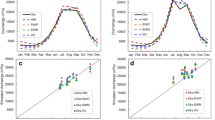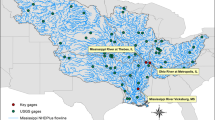Abstract
Hydrological impact studies of climate change increasingly take land use changes into account. However, the Midwestern USA is still understudied in this context. This study investigated the impacts of potential climate change and urban growth on the streamflow characteristics of the Milwaukee River located in southeastern Wisconsin. The Hydrological Simulation Program-Fortran (HSPF) was set up for the catchment and calibrated against observed streamflow data. The calibrated HSPF model was run with a series of climate and urban growth scenarios generated from nine global climate models (GCMs) and a land use simulation model, respectively. The outcomes from the GCMs, statistically downscaled at 10-km grid spacing, generally indicated a warmer and wetter climate by the mid-twenty-first century, and the land use simulation model projected moderate urban growth by the time. Major findings from the study include: (1) land use changes alone resulted in negligible streamflow changes; (2) low flows showed more sensitivity than mean streamflow to climate change; (3) streamflow variability increased with both land use and climate changes, and (4) uncertainty in simulated streamflow among GCMs was larger than uncertainty among the GCM output themselves. The findings suggest that the current pace of urban growth would not pose much threat to the water resources in the area. Considering that low flow indices responded more sensitively than mean streamflow to climate change, measures to improve resilience to drought conditions are recommended. Because land use change impacts were quite small, considering the impact of both climate and land use scenarios did not produce a significantly different result.




Similar content being viewed by others
References
Breyer B, Chang H, Parandvash GH (2012) Land-use, temperature, and single-family residential water use patterns in Portland, Oregon and Phoenix, Arizona. Appl Geogr 35:142–151. doi:10.1016/j.apgeog.2012.06.012
Castillo CR, Güneralp İ, Güneralp B (2014) Influence of changes in developed land and precipitation on hydrology of a coastal Texas watershed. Appl Geogr 47:154–167. doi:10.1016/j.apgeog.2013.12.009
Chang H, Praskievicz S, Parandvash H (2014) Sensitivity of urban water consumption to weather and climate variability at multiple temporal scales: The Case of Portland, Oregon. International Journal of Geospatial and Environmental Research 1: No. 1, Article 7. http://dc.uwm.edu/ijger/vol1/iss1/7
Choi W (2008) Catchment-scale hydrological response to climate-land-use combined scenarios: a case study for the Kishwaukee River basin, Illinois. Phys Geogr 29:79–99. doi:10.2747/0272-3646.29.1.79
Choi W, Deal BM (2008) Assessing hydrological impact of potential land use change through hydrological and land use change modeling for the Kishwaukee River basin (USA). J Environ Manag 88:1119–1130. doi:10.1016/j.jenvman.2007.06.001
Choi W, Kim S, Lee M, Koenig K, Rasmussen P (2014) Hydrological impacts of warmer and wetter climate in Troutlake and Sturgeon River Basins in Central Canada. Water Resour Manag 28:5319–5333. doi:10.1007/s11269-014-0803-z
Choi W, Nauth K, Choi J, Becker S (2016) Urbanization and rainfall–runoff relationships in the Milwaukee River Basin. Prof Geogr 68:14–25. doi:10.1080/00330124.2015.1007427
Chung E, Park K, Lee KS (2011) The relative impacts of climate change and urbanization on the hydrological response of a Korean urban watershed. Hydrol Process 25:544–560. doi:10.1002/hyp.7781
Collins M, Knutti R, Arblaster J, Dufresne J, Fichefet T, Friedlingstein P, Gao X, Gutowski WJ, Johns T, Krinner G, Shongwe M, Tebaldi C, Weaver AJ, Wehner M (2013) Long-term climate change: projections, commitments and irreversibility. In: Stocker TF, Qin D, Plattner G, Tignor M, Allen SK, Boschung J, Nauels A, Xia Y, Bex V, Midgley PM (eds) Climate change 2013: the physical science basis. Contribution of working group I to the fifth assessment report of the intergovernmental panel on climate change. Cambridge University Press, Cambridge, pp 1029–1136
Duda PB, Hummel PR, Donigian Jr AS, Imhoff JC (2012) BASINS/HSPF: model use, calibration, and validation. Trans Asabe 55(4):1523–1547
El-Khoury A, Seidou O, Lapen DR, Que Z, Mohammadian M, Sunohara M, Bahram D (2015) Combined impacts of future climate and land use changes on discharge, nitrogen and phosphorus loads for a Canadian river basin. J Environ Manag 151:76–86. doi:10.1016/j.jenvman.2014.12.012
Hartmann DL, Klein Tank AMG, Rusticucci M, Alexander LV, Brönnimann S, Charabi Y, Dentener FJ, Dlugokencky EJ, Easterling, Kaplan A, Soden BJ, Thorne PW, Wild M, Zhai PM (2013) Observations: atmosphere and surface. In: Stocker TF, Qin D, Plattner G, Tignor M, Allen SK, Boschung J, Nauels A, Xia Y, Bex V, Midgley PM (eds) Climate change 2013: the physical science basis. Contribution of working group I to the fifth assessment report of the intergovernmental panel on climate change. Cambridge University Press, Cambridge, pp 159–254
Homer CH, Fry JA, Barnes CA (2012) The National Land Cover Database U.S. Geological Survey Fact Sheet 2012–3020:4
Hoyer R, Chang H (2014) Assessment of freshwater ecosystem services in the Tualatin and Yamhill basins under climate change and urbanization. Appl Geogr 53:402–416. doi:10.1016/j.apgeog.2014.06.023
Jacobson CR (2011) Identification and quantification of the hydrological impacts of imperviousness in urban catchments: a review. J Environ Manag 92:1438–1448. doi:10.1016/j.jenvman.2011.01.018
Jha MK, Gassman PW (2014) Changes in hydrology and streamflow as predicted by a modelling experiment forced with climate models. Hydrol Process 28:2772–2781. doi:10.1002/hyp.9836
Kalnay E, Kanamitsu M, Kistler R, Collins W, Deaven D, Gandin L, Iredell M, Saha S, White G, Woollen J, Zhu Y, Chelliah M, Ebisuzaki W, Higgins W, Janowiak J, Mo KC, Ropelewski C, Wang J, Leetmaa A, Reynolds R, Jenne R, Joseph D (1996) The NCEP/NCAR 40-year reanalysis project. Bull Am Meteorol Soc 77:437–471. doi:10.1175/1520-0477(1996)077<0437:TNYRP>2.0.CO;2
Leavesley GH (1994) Modeling the effects of climate-change on water-resources—a review. Clim Change 28:159–177. doi:10.1007/BF01094105
Lee S, Chang H, Gober P (2015) Space and time dynamics of urban water demand in Portland, Oregon and Phoenix, Arizona. Stoch Environ Res Risk Assess 29:1135–1147. doi:10.1007/s00477-014-1015-z
Li W, Wu C, Zang S (2014) Modeling urban land use conversion of Daqing City, China: a comparative analysis of “top-down” and “bottom-up” approaches. Stoch Environ Res Risk Assess 28:817–828. doi:10.1007/s00477-012-0671-0
López-Moreno JI, Zabalza J, Vicente-Serrano SM, Revuelto J, Gilaberte M, Azorin-Molina C, Morán-Tejeda E, García-Ruiz JM, Tague C (2014) Impact of climate and land use change on water availability and reservoir management: scenarios in the Upper Aragón River, Spanish Pyrenees. Sci Total Environ 493:1222–1231. doi:10.1016/j.scitotenv.2013.09.031
Meehl GA, Stocker TF, Collins WD, Friedlingstein P, Gaye AT, Gregory JM, Kitoh A, Knutti R, Murphy JM, Noda A, Raper SCB, Watterson IG, Weaver AJ, Zhao Z-C (2007) Global climate projections. In: Solomon S, Qin D, Manning M, Chen Z, Marquis M, Averyt KB, Tignor M, Miller HL (eds) Climate change 2007: the physical science basis. Contribution of working group I to the fourth assessment report of the intergovernmental panel on climate change. Cambridge University Press, Cambridge, pp 747–845
Mishra AK, Singh VP (2010) A review of drought concepts. J Hydrol 391:202–216. doi:10.1016/j.jhydrol.2010.07.012
Nakicenovic N, Swart R (2000) Special report on emissions scenarios. Cambridge University Press, Cambridge, p 599
Nash JE, Sutcliffe JV (1970) River flow forecasting through conceptual models part I—a discussion of principles. J Hydrol 10:282–290
Notaro M, Lorenz DJ, Vimont D, Vavrus S, Kucharik C, Franz K (2011) 21st century Wisconsin snow projections based on an operational snow model driven by statistically downscaled climate data. Int J Climatol 31:1615–1633. doi:10.1002/joc.2179
Praskievicz S, Chang H (2011) Impacts of climate change and urban development on water resources in the Tualatin River Basin, Oregon. Ann Assoc Am Geogr 101:249–271. doi:10.1080/00045608.2010.544934
Prudhomme C, Jakob D, Svensson C (2003) Uncertainty and climate change impact on the flood regime of small UK catchments. J Hydrol 277:23. doi:10.1016/S0022-1694(03)00065-9
Psaris M, Chang H (2014) Assessing the impacts of climate change, urbanization, and filter strips on water quality using SWAT. International Journal of Geospatial and Environmental Research 1: No. 2 Article 1. http://dc.uwm.edu/ijger/vol1/iss2/1
Qiao L, Pan Z, Herrmann RB, Hong Y (2014) Hydrological variability and uncertainty of lower Missouri river basin under changing climate. J Am Water Resour Assoc 50:246–260. doi:10.1111/jawr.12126
Serbin SP, Kucharik CJ (2009) Spatiotemporal mapping of temperature and precipitation for the development of a multidecadal climatic dataset for Wisconsin. J Appl Meteorol Climatol 48:742–757. doi:10.1175/2008JAMC1986.1
Sivakumar B (2011) Global climate change and its impacts on water resources planning and management: assessment and challenges. Stoch Environ Res Risk Assess 25:583–600. doi:10.1007/s00477-010-0423-y
Smakhtin VU (2001) Low flow hydrology: a review. J Hydrol 240:147–186
Tavakoli M, De Smedt F (2012) Impact of climate change on streamflow and soil moisture in the Vermilion Basin, Illinois. J Hydrol Eng 17:1059–1070. doi:10.1061/(ASCE)HE.1943-5584.0000546
Tong STY, Sun Y, Ranatunga T, He J, Yang YJ (2012) Predicting plausible impacts of sets of climate and land use change scenarios on water resources. Appl Geogr 32:477–489. doi:10.1016/j.apgeog.2011.06.014
Tu J (2009) Combined impact of climate and land use changes on streamflow and water quality in eastern Massachusetts, USA. J Hydrol 379:268–283. doi:10.1016/j.jhydrol.2009.10.009
US EPA (2013) Flow 101. http://water.epa.gov/scitech/datait/models/dflow/flow101.cfm#1Q10. Accessed 26 May 2015
US EPA (2015) BASINS 4.1 (Better Assessment Science Integrating point and Non-point Sources) Modeling Framework. National Exposure Research Laboratory, RTP, North Carolina. https://www.epa.gov/exposure-assessment-models/basins. Accessed 22 August 2016
U.S. Geological Survey (2015) Surface water data for USA: USGS surface-water monthly statistics. http://waterdata.usgs.gov/nwis/monthly?. Accessed 19 May 2015
Van Loon AF (2015) Hydrological drought explained. Wiley Interdiscip Rev Water 2:359–392. doi:10.1002/wat2.1085
Van Roosmalen L, Sonnenborg TO, Jensen KH (2009) Impact of climate and land use change on the hydrology of a large-scale agricultural catchment. Water Resour Res 45:W00A15. doi:10.1029/2007WR006760
Wang R, Kalin L, Kuang W, Tian H (2014) Individual and combined effects of land use/cover and climate change on Wolf Bay watershed streamflow in southern Alabama. Hydrol Process 28:5530–5546. doi:10.1002/hyp.10057
Wilby RL, Harris I (2006) A framework for assessing uncertainties in climate change impacts: low-flow scenarios for the River Thames, UK. Water Resour Res 42:W02419. doi:10.1029/2005WR004065
Winter JM, Yeh PJ-, Fu X, Eltahir EAB (2015) Uncertainty in modeled and observed climate change impacts on American Midwest hydrology. Water Resour Res 51:3635–3646. doi:10.1002/2014WR016056
Wisconsin Department of Natural Resources (2001) The State of the Milwaukee River Basin PUBL WT 704 2001
Wisconsin Initiative on Climate Change Impacts (2011) Wisconsin's changing climate: impacts and adaptation, Nelson Institute for Environmental Studies, University of Wisconsin-Madison and the Wisconsin Department of Natural Resources. http://www.wicci.wisc.edu/report/2011_WICCI-Report.pdf
Wisconsin State Climatology Office (2007) Historical climate data. http://www.aos.wisc.edu/~sco/clim-history/division/4709-climo.html. Accessed 19 May 2015
Wu Y, Liu S, Abdul-Aziz OI (2012) Hydrological effects of the increased CO2 and climate change in the Upper Mississippi River Basin using a modified SWAT. Clim Change 110:977–1003. doi:10.1007/s10584-011-0087-8
Xu CY, Widen E, Halldin S (2005) Modelling hydrological consequences of climate change—progress and challenges. Adv Atmos Sci 22:789–797. doi:10.1007/BF02918679
Acknowledgements
This work was supported in part under a grant from the U.S. Geological Survey, U.S. Department of Interior, federal grant number G11AP20115, Project 2013WI314B and with funds from the University of Wisconsin-Milwaukee.
Author information
Authors and Affiliations
Corresponding author
Additional information
Editor: Juan Ignacio Lopez Moreno.
Electronic supplementary material
Below is the link to the electronic supplementary material.
Rights and permissions
About this article
Cite this article
Choi, W., Pan, F. & Wu, C. Impacts of climate change and urban growth on the streamflow of the Milwaukee River (Wisconsin, USA). Reg Environ Change 17, 889–899 (2017). https://doi.org/10.1007/s10113-016-1083-3
Received:
Accepted:
Published:
Issue Date:
DOI: https://doi.org/10.1007/s10113-016-1083-3




